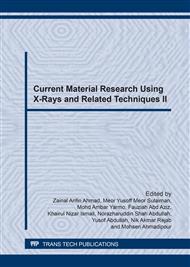p.418
p.423
p.428
p.435
p.441
p.447
p.453
p.458
p.462
Influence of Reduction Temperatures on Reduction of FeO-Containing Slag by Agricultural Waste
Abstract:
Generally, the conventional carbon sources such coke/coal are used in EAF steelmaking attributed the highest growth rate in energy consumption. A substitute routes striving to improve energy efficiency by providing auxiliary sources is essential. The unique features such high carbon content, surface area, porosity and low sulphur was available in agricultural waste clearly have the potential to be used as reducing agent in steelmaking process. The present study investigated the reduction behavior of EAF slag and production of metallic iron by reduction process. The carbon materials, coke and palm char (pyrolyzed via chemical activation) were used as reducing agent composite with EAF slag respectively. The reduction reaction was conducted in horizontal tube furnace at different reduction temperatures (1250°C, 1350°C, 1450°C and 1550°C) under argon gas (flow rate 0.01L/min) within 20 minutes. The reduced sample was examined by X-ray Diffraction (XRD) and Scanning Electron Microscope (SEM) to understand the reduction behavior of both composite samples. Palm char showed more efficient due to improvement in degree of FeO reduction which was 57.72% compared to coke, 26.72%. The phase movement from iron oxide to iron was influenced by the reduction temperatures. XRD pattern revealed that the metallic iron was initiating appeared at temperature 1250°C and completely reduced at temperature of 1550°C . Predominant peak of metallic iron and the other oxides was clarified by EDS spectra. This study found that palm char has viability to be used as carbon sources in steelmaking applications.
Info:
Periodical:
Pages:
441-446
Citation:
Online since:
March 2017
Keywords:
Price:
Сopyright:
© 2017 Trans Tech Publications Ltd. All Rights Reserved
Share:
Citation:


